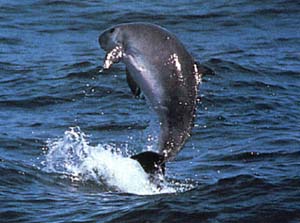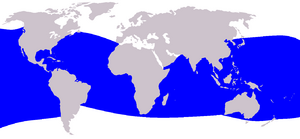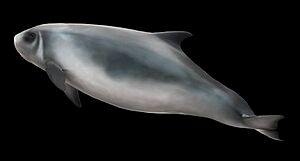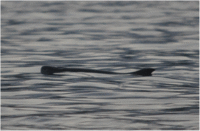Dwarf sperm whale facts for kids
Quick facts for kids Dwarf sperm whale |
|
|---|---|
 |
|
 |
|
| Size compared to an average human | |
| Conservation status | |
| Scientific classification | |
| Genus: |
Kogia
|
| Species: |
sima
|
 |
|
| Dwarf sperm whale range | |
| Synonyms | |
The dwarf sperm whale (Kogia sima) is a small whale found in warm and mild oceans all over the world. It likes to live near the edges of continents, where the ocean floor slopes down.
This whale was first described in 1866 by a biologist named Richard Owen. He used drawings made by Sir Walter Elliot. For many years, people thought the dwarf sperm whale was the same as the pygmy sperm whale. But in 1998, scientists realized they were different species.
Dwarf sperm whales are small, growing to about 2 to 2.7 meters (6.5 to 9 feet) long and weighing 136 to 272 kilograms (300 to 600 pounds). They are grey with a square-shaped head and a small jaw. They look a lot like pygmy sperm whales. The main way to tell them apart is where their dorsal fin is located. On a dwarf sperm whale, it's closer to the middle of its back.
These whales mostly eat squid by sucking them up. They usually live in small groups of one to four whales. Bigger animals like killer whales and large sharks sometimes hunt them. If a dwarf sperm whale gets scared, it can squirt out a cloud of red-brown liquid to hide itself. Most of what we know about these whales comes from ones that have washed up on beaches, because they are rarely seen in the ocean.
People in some parts of Asia hunt dwarf sperm whales in small numbers. A bigger problem for them is eating or getting caught in plastic trash in the ocean. Scientists don't know exactly how many dwarf sperm whales there are worldwide. Because of this, the International Union for Conservation of Nature (IUCN) lists them as "least concern," meaning they are not currently in danger of disappearing.
Contents
About Dwarf Sperm Whales
The first dwarf sperm whale specimens were found in 1853 by Sir Walter Elliot. He thought they were a type of porpoise because of their short snout. He sent drawings to biologist Richard Owen, who realized they were a kind of sperm whale. Owen noticed they had teeth only in their lower jaw and a blowhole that was lopsided. He named the species Physeter (Euphysetes) simus. The name simus means "stump-nosed" in Latin, referring to its blunt snout.
Later, the dwarf sperm whale was moved to the genus Kogia. In 1878, scientists thought the dwarf sperm whale was the same as the pygmy sperm whale. This idea lasted until 1998, when new research showed they were different species.
Some genetic studies suggest that there might be two different kinds of K. sima: one in the Atlantic Ocean and one in the Indo-Pacific region.
Size and Appearance

Dwarf sperm whales are smaller than pygmy sperm whales. They are usually 2 to 2.7 meters (6.5 to 9 feet) long and weigh 136 to 272 kilograms (300 to 600 pounds). When they are born, they are about 1 meter (3 feet) long and weigh 14 kilograms (30 pounds).
Males become fully grown around age 15, and females around age 13. They can start having babies when they are about 2 to 2.2 meters (6.5 to 7.2 feet) long. Males reach this stage at 2 to 3 years old, and females around 5 years old. A baby whale grows inside its mother for about 9.5 months.
Dwarf sperm whales are dark grey or blue-grey on top and lighter grey underneath. They have a pale, curved mark between their eye and flipper, which looks a bit like a fake gill. This mark is special to Kogia whales. They have a tall dorsal fin that is about halfway down their back. This fin is taller and closer to the head than on a pygmy sperm whale.
Kogia whales have a square-shaped head and a small jaw with a snout that sticks out. Their body is strong and gets thinner quickly towards the tail. They have the shortest snouts of any modern whale. Like other sperm whales, their left nostril is much bigger than their right one. Their brain weighs about 0.5 kilograms (1 pound). Their eyes are good at seeing in dim light.
Dwarf sperm whales have 14 to 24 sharp, slightly curved teeth in their lower jaw. These teeth do not have enamel. They are usually less than 30 millimeters (1.2 inches) long. They might have up to 6 teeth in their upper jaw, but these teeth are not used for chewing.
A unique thing about Kogia whales is a special sac connected to their small intestines. This sac holds a thick, red-brown liquid, like chocolate syrup. When the whale is stressed or scared, it can release this fluid. Dwarf sperm whales have between 50 and 57 bones in their spine. They do not look different based on whether they are male or female.
Where They Live
Dwarf sperm whales live in tropical and mild oceans around the world. They prefer areas near the continental shelf and slope, which are parts of the ocean floor that slope downwards from the land. They seem to like warmer water more than pygmy sperm whales do.
These whales are often found stranded on beaches, even though they are rarely seen in the open ocean. Most of what we know about them comes from studying these stranded whales. How deep they dive can change depending on where they are. In the Bahamas, they dive about 250 meters (820 feet) deep. In deeper waters near Hawaii, they might dive around 1500 meters (4900 feet).
Dwarf sperm whales have been seen from Japan to New Zealand in the West Pacific, and from British Columbia to Chile in the East Pacific. In the Indian Ocean, they are found near Oman, Sri Lanka, India, Thailand, Indonesia, Australia, and South Africa. In the Atlantic Ocean, they are seen from Virginia to Brazil, and from Italy to South Africa.
Scientists have not yet estimated the total number of dwarf sperm whales in the world. However, they have counted them in certain areas. In the North Atlantic, there are an estimated 3,785 individuals. In the East Pacific, there are about 11,200. These numbers often include both dwarf and pygmy sperm whales because they are hard to tell apart at sea.
What They Eat

Dwarf sperm whales are hunters of the open ocean. They mainly eat squid. They also eat some deep sea fish and crustaceans. In Hawaii, crustaceans can make up a good part of their diet, up to 15%. Whales found in different parts of the world often have cock-eyed squid and glass squid in their stomachs, especially the elongate jewel squid.
The muscles in their throat and the grooves there help them to suck up food. This "suction feeding" is very well developed in these whales. Their blunt snout, few teeth, and small jaw also help them with this feeding method. They use their sharp teeth to hold onto their prey while pushing water out of their mouth.
Baby dwarf sperm whales start eating solid food when they are about 1.35 meters (4.4 feet) long. They are fully weaned from their mother's milk when they reach about 1.5 meters (4.9 feet).
Threats and Dangers
Killer whales and sharks are known to hunt dwarf sperm whales. Remains of dwarf sperm whales have been found in the stomachs of great white sharks.
Dwarf sperm whales also compete for food with other whales that eat squid, like beaked whales. They live in the same areas as pygmy sperm whales and eat similar foods. However, pygmy sperm whales can hunt in deeper waters and eat a wider variety of larger prey.
Some stranded dwarf sperm whales have died from many parasites, like worms in their stomach and tapeworms in their blubber. In the southeastern United States, some stranded whales died from heart problems.
Even though dwarf sperm whales live in deep waters far from shore, they have ways to escape danger. If a dwarf sperm whale gets scared, it can release a red liquid. This creates a cloud that can stop or distract predators. This allows the whale to dive deep and get away.
Dwarf sperm whales have recently been seen closer to the surface, which puts them at risk from humans. In Japan and Indonesia, some dwarf sperm whales are accidentally caught in fishing nets and sold in fish markets. They also face health risks from ocean pollution, eating plastic trash, and possibly getting hit by ships.
Behavior
Kogia whales are thought to be slow swimmers. They rarely come to the surface quickly. Instead, they tend to float at the surface with only their back and dorsal fin showing. When they dive, they sink straight down without lifting their tails out of the water, so they don't make a splash.
Dwarf sperm whales usually gather in small groups of one to four whales, but sometimes up to ten. This small group size might be because there isn't a lot of food, or it could be a way to avoid predators. However, dolphins often form very large groups to protect themselves from predators.
These whales might follow squid as they move from offshore areas in the summer to closer to shore in the winter. They might prefer sloped areas of the ocean floor because it helps them herd squid against the slope, or because the slopes create currents that help them save energy while hunting. Younger whales might stay in shallower areas, while adults go to deeper ones. The slope around South Africa might be a place where baby whales are raised.
Unlike other whales, Kogia whales can squirt a red-brown fluid when they are startled. This is probably to distract predators, much like a squid does. This cloud can spread out to cover an area of 100 square meters (1076 square feet) in the water.
Dwarf sperm whales do not whistle. Instead, they make high-frequency clicks. These clicks are more like those made by some dolphins and porpoises than those made by other deep-diving whales. The highest sounds they make are usually less than 130 kilohertz.
Dwarf Sperm Whales and People
Dwarf sperm whales are hunted in small numbers in Indonesia, Japan, Sri Lanka, and the Lesser Antilles. They are caught for food or for bait, but there are no large hunting operations. A bigger threat is likely eating marine debris (trash in the ocean) and getting caught in fishing gear. However, scientists are still trying to figure out how serious these threats are.
The International Union for Conservation of Nature (IUCN) currently says there isn't enough information to know the exact conservation status of the dwarf sperm whale. But it might be a "least concern" species, meaning it's not currently at high risk.
The dwarf sperm whale is protected by several international agreements. These include the Convention on International Trade in Endangered Species of Wild Fauna and Flora (CITES) and agreements for protecting whales in the Black Sea, Mediterranean Sea, Atlantic Ocean, Western Africa, and the Pacific Islands.
See also
- Kogia pusilla
- List of cetaceans






